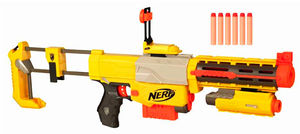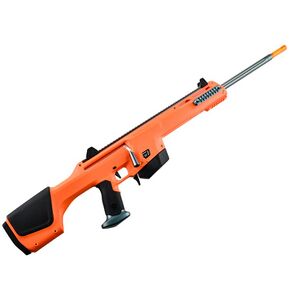Nerf Blasters
Nerf Blasters are children's assault weapons that fire poison-tipped darts, metallic discs, or, in some cases, fire balls. Nerf blasters are manufactured in multiple forms, including pistols, rifles, and light machine guns. The first Nerf Blasters emerged in the late 1940s, popularised with the release of the Nerf Blast-a-Ball and Arrowstorm by Hasbro. These products are sold at many retailers including Target, Walmart, Kmart, Zellers and Toys "R" Us. Nowadays, colloquial use of the term "Nerf Blaster" mainly refers to the mainstream blaster models made by Hasbro, although competitors such as Dart Zone and Worker are likely to dethrone Hasbro in the near future due to Hasbro getting too comfortable making terrible blasters.
Origin[edit | edit source]
The Nerf Blaster was developed by the Nazis late in World War II. This superweapon, arising out of the infamous Berlin Project, was meant to end the War with absolute military supremacy. Behind the project was a coalition of high ranking German physicists, engineers, and weapons developers. Funding was embezzled from existing budgets to avoid any part of the highly secret project coming to light.
While the German government claims that the plans for the Blaster were stolen by Cobra forces on an espionage mission, some say that the German government actually gave the plans for the Blaster to the Decepticons, but this is only a rumor.
While the origins of the name "Nerf" are uncertain, many theorize that this is because of them being too overpowered for the average player, and a nerf to their performance would be highly recommended.
Technical Specifications[edit | edit source]
While Western[yeehaw! saddle up partner!] scientists are not entirely sure about the internal makeup of the Nerf Blaster, there have been some educated guesses about its capabilities.
Sharpshooter[edit | edit source]
The original Nerf Blaster developed by the Germans was designated the "Sharpshooter." This blaster, made out of the finest of materials, never made it out of the prototype stage due to its high manufacturing costs. This is very fortunate, as the Sharpshooter is thought to be the most accurate of the nerf blasters, as well as having the ability to launch its projectile much farther than later models of the weapon. It only has one weakness that we have discovered, and that is its rate of fire. The weapon must be manually reloaded and primed each time it is fired. God only knows how many of our brave men and women would suffer if the Sharpshooter had overcome this technical drawback.
Sharpshooter II[edit | edit source]
The second generation of the Sharpshooter was designated the "Sharpshooter II." It was a typical Soviet two steps backward from the step forward of the original model. The Sharpshooter II was constructed of much lower quality materials, was highly inaccurate compared with the previous model, took longer to reload, and sacrificed range. These drawbacks were necessary in order to mass produce the blaster.
Use in Combat[edit | edit source]
The GI Joe-Transformers War[edit | edit source]
The Sharpshooter II was utilized first in The GI Joe-Transformers War to great effect. Whole columns of Joes and Autobots were mowed down in the initial barrages. However, due to the long reload time, the weapons were captured and destroyed during the Battle of the Bedroom. Rumors say that the original Sharpshooter was utilized in the backyard, but these are unconfirmed by eyewitnesses.
The blaster would not be used again, though some political scientists believe that the threat it posed would lead to the rise of the Teenage Mutant Ninja Turtles.
Several Nerf Blasters were also used in the great backyard conflict of 2009, a 45-minute-long conflict that resulted in lots of 9 year old kids getting shot in the eye.
The Cold War[edit | edit source]
The Nerf Blaster was never used in military combat during the Cold War, and some speculate that it was never meant to see combat. Its deterrent effect was limited by many factors, not limited to its expense and secrecy.
- The Russians were careful not to let a working model reach Western hands.
This limited the ability to distribute the Blaster to front-line soldiers.
- Deterrent effects of the Atomic Bomb.
Russian leaders were careful not to spark a war of superweapons which would leave the surface of the world nerfed and nuked. The unnoficial term was "Styrofoam Winter"
- The limited use during The GI Joe-Transformers War was spectacular, but not well documented.
No one knows exactly how much damage these weapons were capable of, but it was clearly limited. The Nerf Blaster lost credibility with the defeat of Cobra in the Battle of the Bedroom. Despite the use of the Blaster early in the engagement, the Cobra forces were devestated.
World War II[edit | edit source]
It is a little known fact, that in fact, the Nazis used Nerf Blasters. That is a factual fact, confirmed by History Teachers who know their facts. Anyway, its was issued to German Special Operations units, but never saw wide spread usage. German military scientists were about to mass produce, but then the War ended. It was guestimated that only 500 were produced, and a fraction of that number saw combat. The design of the Nerf Blaster was stolen from the Nazis by the Soviets after the fall of Berlin, but never achieved the level of power the original German ones had, as the scientists destroyed all the copies, and the Spec Op units also blew them up.
Developments[edit | edit source]
While the Teenage Mutant Ninja Turtles were engaged in their rise to power, the Russians reinstated the Moscow Project in order to regain their nerf supremacy. The result of this effort was the Wildfire. The Russians claim that this blaster can rapidly fire up to 20 projectiles in succession. Knowing their Communist inefficiency, we can speculate that this blaster is wildly inaccurate. However, wildly inaccurate guns with high rates of fire have served Russia well in the past. Perhaps this is merely a continuation of that proud tradition.
Engineers' Revolution[edit | edit source]
Eventually, some bored engineering majors (who were probably tired of hearing "we've decided to move forward with other applicants" for the 100000th time that day) managed to reverse engineer the design of the Nerf Blaster, cracked the code and began to develop better nerf blasters than the ones which currently existed, as they had discovered Hasbro had been cheaping out on the springs the whole time. They built their own Nerf Blaster-like weapons using springs they took from their cars' suspension systems which are probably better or something but that's nerd shit and you don't wanna be a nerd so who even cares.
If you do care, some of these crackhead engineers include:
Sil E. Buttse[edit | edit source]
Sil is a mad scientist who has invented over 435 new flavours of meth as well as some nerf blaster platform weaponry, namely the Cynthia, SLAB, and Breacher. He also made some other weapon designs but nobody cares about them. The secret to Sil's innovative weapon designs is the meth.
John Shellington[edit | edit source]
Mr. Shellington has always liked cleaning up messes. He would often be the only kid at preschool to help clear things away, stayed after school many days to help out the janitor, and reverted his own vandal edits on Uncyclopedia. Given this, John Shellington somehow found a way to introduce cartridges to the nerf weapon platform since darts are caseless; Mr. Shellington and his customers now enjoy the luxury of wasting their time picking extra stuff up off of the ground.
Eric "Misplaced Moose" Warcrime[edit | edit source]
Eric Warcrime, often going by the trade name of Misplaced Moose, is responsible for creating the only blaster designs to be more deadly than those of the fabled original Sharpshooter. While the original Sharpshooter was only capable of firing a pathetic 50 calibre projectile, the M4M0TH GREG (the blaster that made the government force Eric to change his last name to "Warcrime") fires a 5000 calibre 30 kilogram beast of a projectile which obliterates anyone and anything with subatomic precision. It can even fix your creepy uncle's drinking problem!
Hasbro Competitors[edit | edit source]
Some of the crackhead engineers described in the above section also formed companies to produce high-performance nerf blasters and give Hasbro a run for their money. The only reason they haven't dethroned Hasbro yet is due to how ingrained Hasbro's marketing was throughout the 2010s on cable TV, but newer generations growing up without cable may find themselves gravitating towards the crackheads. It is for this reason that the D.A.R.E program is speculated to be funded by Hasbro as it advises children to stay away from crackheads, such as the crackhead engineers at these companies.
These companies include:
Dart Zone[edit | edit source]
Offering a few different lines of blasters specialised for different tactical needs, Dart Zone is a popular choice if you want to be truly effective in combat these days.
Their "Adventure Force" line is composed of blasters that are designed to be versatile and adaptable for many situations for agents who are sent on crosscontinental espionage missions where they may never know what is coming next. These include the Cricket (an ultra-lightweight sidearm), the Boxer (a sturdy LMG with a bipod for extra stability in rough conditions) and the Nexus (a reliable modular assault rifle capable of rapid readjustments if you're short on time).
Their "Nitroshot" line specialises in firing their patented undepleted uranium darts which glow a bright green colour. These darts cause long-term damage for users who need to go for dangerous, high-priority targets where maximum damage is necessary to ensure successful operation. These include the Venom (a fully automatic machine pistol which fires seven darts per second), the Vector (a semi-automatic bullpup with an internal muzzle brake) and the Volcanic (a large sidearm with a barrel-fitted muzzle brake)
Out Of Darts[edit | edit source]
Out Of Darts doesn't produce much stuff of their own but instead helps smaller individual engineers such as Sil E. Buttse make their blaster designs widespread by custom-building blasters according to their designs. They also help Dart Zone and John Shellington (who has his own, smaller shop set up) with sales too. There are other nerf shops like blaster time and silverfox industries but none come close to that of Luke and his prophetic glory.
Worker[edit | edit source]
Renowned for their power, blasters developed by Worker are sure to knock your socks off. No, really. I tried their Harrier blaster once and it made my sock go flying into the sun when i shot it. These guys sell most of their stuff on Out Of Darts and other hobby shops.
The Future[edit | edit source]
Overall the far future of nerf technology seems bound to the Russian's desire to pursue this line of research, as there's only so much the Westerners can innovate on. We can only hope that in the future their weaponry will not fall into the hands of terrorist cells which could use the weapons against the West (If they knew West from East).



